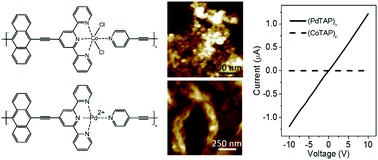Influence of the supramolecular order on the electrical properties of 1D coordination polymers based materials†
Abstract
The generation, under self-assembly conditions, of coordination polymers on surface based combinations of a terpyridine–antracene–pyridine based tecton and Co(II) or Pd(II) cations is primarily governed by the coordination geometry of the metal center (octahedral and square planar respectively). While the octahedral Co(II) based polymer self-assembles in insulating films exhibiting randomly oriented crystalline domains, the planarity of Pd(II) based polymers leads to the formation of conductive π–π stacked fibrillar structures exhibiting anisotropically oriented domains. In the latter case, the favorable Pd–Pd and anthracene–anthracene wavefunction overlaps along the fiber direction are responsible for the large electronic couplings between adjacent chains, whereas small electronic couplings are instead found along individual polymer chains. These results provide important guidelines for the design of conductive metal coordination polymers, highlighting the fundamental role of both intra- as well as inter-chain interactions, thus opening up new perspectives towards their application in functional devices.


 Please wait while we load your content...
Please wait while we load your content...